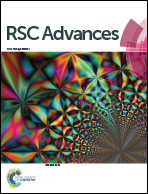Multifunctional core–shell polymer–inorganic hybrid nanofibers prepared via block copolymer self-assembly†
Abstract
We demonstrate a simple and robust approach for preparing multifunctional core–shell hybrid nanofibers via block copolymer self-assembly. The approach utilizes the different chemistry and solubilities of the two blocks of a diblock copolymer and different affinity of functional inorganic nanoparticles towards block copolymer constituents. In the first step, the silver nanoparticles (Ag) modified with short-chain polystyrene (PS) ligand are incorporated in the cylindrical domains of a polystyrene-block-poly(4-vinylpyridine) (PS-b-P4VP) block copolymer, constituted of PS blocks. The Ag-loaded cylindrical domains are then isolated as nanofibers by swelling the matrix forming P4VP phase using a selective solvent. The isolated nanofibers exhibit core–shell morphology with the core constituted of Ag-loaded PS phase and shell consisting of P4VP chains. The reactive P4VP shell of the nanofibers is subsequently used as a host for depositing a second type of nanoparticles. The second type of nanoparticles could be either directly synthesized on the P4VP shell or deposited from an aqueous dispersion of pre-synthesized nanoparticles. In this work, gold (Au) and cadmium sulfide (CdS) nanoparticles were deposited on the nanofiber shell. The approach is versatile and, in principle, could be extended to the fabrication of various combinations of targeted functionalities in a single nanofiber with core–shell morphology.


 Please wait while we load your content...
Please wait while we load your content...